Assessing the Impact of Tillage Methods on Soil Moisture Content and Crop Yield in Hungary
Abstract
:1. Introduction
2. Materials and Methods
2.1. Study Location
2.2. Experimental Design
2.3. Soil Moisture Measurement
2.4. Grain Yield and Root Weight Were Recorded
2.5. Statistical Analysis
3. Results
3.1. The Effect of Tillage on SMC
3.2. The Effect of Tillage on Wheat and Sunflower Root Weight and Grain Yield
4. Discussion
4.1. The Effect of Tillage on SMC
4.2. The Effect of Tillage on Wheat and Sunflower Root Weight and Grain Yield
5. Conclusions
Author Contributions
Funding
Data Availability Statement
Acknowledgments
Conflicts of Interest
References
- Gregić, M. Pogodnost tala Oranice i Voćnjaka za Ekološku Poljoprivredu. Doctoral Dissertation, Department for Agroecology, Faculty of Agriculture, Josip Juraj Strossmayer University of Osijek, Osijek, Croatia, 2017. [Google Scholar]
- Zhu, Y.Z.; Li, Y.Y.; Han, J.G.; Yao, H.Y. Effects of changes in water status on soil microbes and their response mechanism: A review. Ying Yong Sheng Tai Xue Bao = J. Appl. Ecol. 2019, 30, 4323–4332. [Google Scholar]
- Wang, X.J.; Zhang, J.Y.; Shahid, S.; Guan, E.H.; Wu, Y.X.; Gao, J.; He, R.M. Adaptation to climate change impacts on water demand. Mitig. Adapt. Strateg. Glob. Chang. 2016, 21, 81–99. [Google Scholar] [CrossRef]
- Qin, W.; Hu, C.; Oenema, O. Soil mulching significantly enhances yields and water and nitrogen use efficiencies of maize and wheat: A meta-analysis. Sci. Rep. 2015, 5, 16210. [Google Scholar] [CrossRef]
- Covelli, C.; Cimorelli, L.; Pagliuca, D.N.; Molino, B.; Pianese, D. Assessment of erosion in river basins: A distributed model to estimate the sediment production over watersheds by a 3Dimensional LS Factor in RUSLE Model. Hydrology 2020, 7, 13. [Google Scholar] [CrossRef]
- Kühling, I.; Redozubov, D.; Broll, G.; Trautz, D. Impact of tillage, seeding rate and seeding depth on soil moisture and dryland spring wheat yield in Western Siberia. Soil Tillage Res. 2017, 170, 43–52. [Google Scholar] [CrossRef]
- Salvia, R.; Egidi, G.; Vinci, S.; Salvati, L. Desertification risk and rural development in Southern Europe: Permanent assessment and implications for sustainable land management and mitigation policies. Land 2019, 8, 191. [Google Scholar] [CrossRef]
- Bottinelli, N.; Angers, D.A.; Hallaire, V.; Michot, D.; Le Guillou, C.; Cluzeau, D.; Heddadj, D.; Menasseri-Aubry, S. Tillage and fertilization practices affect soil aggregate stability in a Humic Cambisol of Northwest France. Soil Tillage Res. 2017, 170, 14–17. [Google Scholar] [CrossRef]
- Gao, L.; Wang, B.; Li, S.; Wu, H.; Wu, X.; Liang, G.; Gong, D.; Zhang, X.; Cai, D.; Degré, A. Soil wet aggregate distribution and pore size distribution under different tillage systems after 16 years in the Loess Plateau of China. Catena 2019, 173, 38–47. [Google Scholar] [CrossRef]
- Lampurlanés, J.; Plaza-Bonilla, D.; Álvaro-Fuentes, J.; Cantero-Martínez, C. Long-term analysis of soil water conservation and crop yield under different tillage systems in Mediterranean rainfed conditions. Field Crop. Res. 2016, 189, 59–67. [Google Scholar] [CrossRef]
- Sun, M.; Ren, A.X.; Gao, Z.Q.; Wang, P.R.; Mo, F.; Xue, L.Z.; Lei, M.M. Long-term evaluation of tillage methods in fallow season for soil water storage, wheat yield and water use efficiency in semiarid southeast of the Loess Plateau. Field Crop. Res. 2018, 218, 24–32. [Google Scholar] [CrossRef]
- Małecka, I.; Blecharczyk, A.; Sawinska, Z.; Plechota, T.; Waniorek, B. Cereals yield response to tillage methods. Fragm. Agron. 2012, 29, 114–123. [Google Scholar]
- Al-Wazzan, F.A.; Muhammad, S.A. Effects of conservation and conventional tillage on some soil hydraulic properties. In IOP Conference Series: Earth and Environmental Science; IOP Publishing: Bristol, UK, 2022; Volume 1060, p. 012002. [Google Scholar]
- Ebabu, K.; Tsunekawa, A.; Haregeweyn, N.; Adgo, E.; Meshesha, D.T.; Aklog, D.; Masunaga, T.; Tsubo, M.; Sultan, D.; Fenta, A.A.; et al. Exploring the variability of soil properties as influenced by land use and management practices: A case study in the Upper Blue Nile basin, Ethiopia. Soil Till. Res. 2020, 200, 104614. [Google Scholar] [CrossRef]
- Estevam, R.F.H.; Peixoto, D.S.; de Melo Filho, J.F.; Amorim, H.C.S.; de Souza Moreira, F.M.; Silva, A.O.; Mouazen, A. Soil properties sensitive to degradation caused by increasing intensity of conventional tillage. Soil Res. 2021, 59, 819–836. [Google Scholar] [CrossRef]
- Gallardo-Carrera, A.; Léonard, J.; Duval, Y.; Dürr, C. Effects of seedbed structure and water content at sowing on the development of soil surface crusting under rainfall. Soil Tillage Res. 2007, 95, 207–217. [Google Scholar] [CrossRef]
- Jug, D.; Jug, I.; Brozović, B.; Vukadinović, V.; Stipešević, B.; Đurđević, B. The role of conservation agriculture in mitigation and adaptation to climate change. Agriculture 2018, 24, 35–44. [Google Scholar] [CrossRef]
- Dekemati, I.; Simon, B.; Vinogradov, S.; Birkás, M. The effects of various tillage treatments on soil physical properties, earthworm abundance and crop yield in Hungary. Soil Tillage Res. 2019, 194, 104334. [Google Scholar] [CrossRef]
- Dekemati, I.; Simon, B.; Bogunovic, I.; Kisic, I.; Kassai, K.; Kende, Z.; Birkás, M. Long term effects of ploughing and conservation tillage methods on earthworm abundance and crumb ratio. Agronomy 2020, 10, 1552. [Google Scholar] [CrossRef]
- Madarász, B.; Jakab, G.; Szalai, Z.; Juhos, K.; Kotroczó, Z.; Tóth, A.; Ladányi, M. Long-term effects of conservation tillage on soil erosion in Central Europe: A random forest-based approach. Soil Tillage Res. 2021, 209, 104959. [Google Scholar] [CrossRef]
- Jakab, G.; Madarász, B.; Szabó, J.A.; Tóth, A.; Zacháry, D.; Szalai, Z.; Kertész, Á.; Dyson, J. Infiltration and soil loss changes during the growing season under ploughing and conservation tillage. Sustainability 2017, 9, 1726. [Google Scholar] [CrossRef]
- Jug, D.; Đurđević, B.; Birkás, M.; Brozović, B.; Lipiec, J.; Vukadinović, V.; Jug, I. Effect of conservation tillage on crop productivity and nitrogen use efficiency. Soil Tillage Res. 2019, 194, 104327. [Google Scholar] [CrossRef]
- IUSS Working Group WRB. World Reference Base for Soil Resources 2014, Update 2015. In International Soil Classification System for Naming Soils and Creating Legends for Soil Maps; World Soil Resources Reports No. 106; FAO: Rome, Italy, 2015. [Google Scholar]
- Tóth, E.; Gelybó, G.; Dencső, M.; Kása, I.; Birkás, M.; Horel, Á. Soil CO2 emissions in a long-term tillage treatment experiment. In Soil Management and Climate Change: Effects on Organic Carbon, Nitrogen Dynamics, and Greenhouse Gas Emissions; Munoz, M., Zornoza, R., Eds.; Elsevier: Amsterdam, The Netherlands, 2017; pp. 293–307. [Google Scholar]
- Ács, F.; Breuer, H.; Skarbit, N. Climate of Hungary in the twentieth century according to Feddema. Theor. Appl. Climatol. 2015, 119, 161–169. [Google Scholar] [CrossRef]
- New, M.; Lister, D.; Hulme, M.; Makin, I. A high-resolution data set of surface climate over global land areas. Clim. Res. 2002, 21, 1–25. [Google Scholar] [CrossRef]
- Csorba, S.; Farkas, C.; Birkás, M. Dual porosity water retention curves for characterizing the effect of tillage. Agrokémia és Talajtan 2011, 60, 335–342. [Google Scholar] [CrossRef]
- Tao, Z.; Li, C.; Li, J.; Ding, Z.; Xu, J.; Sun, X.; Zhou, P.; Zhao, M. Tillage and straw mulching impacts on grain yield and water use efficiency of spring maize in Northern Huang–Huai–Hai Valley. Crop J. 2015, 3, 445–450. [Google Scholar] [CrossRef]
- Guan, D.; Zhang, Y.; Al-Kaisi, M.M.; Wang, Q.; Zhang, M.; Li, Z. Tillage practices effect on root distribution and water use efficiency of winter wheat under rain-fed condition in the North China Plain. Soil Tillage Res. 2015, 146, 286–295. [Google Scholar] [CrossRef]
- Budu, M.; Atta-Darkwa, T.; Amaglo, H.; Kyei-Baffour, N.; Aidoo, I.A.; Ahorsu, S.K.; Bessah, E. The impact of tillage and weed control methods on physical properties of sandy clay loam forest ochrosol in Cassava cultivation. Appl. Environ. Soil Sci. 2022, 2022, 6758284. [Google Scholar] [CrossRef]
- Ramos, M.C.; Pareja-Sánchez, E.; Plaza-Bonilla, D.; Cantero-Martínez, C.; Lampurlanés, J. Soil sealing and soil water content under no-tillage and conventional tillage in irrigated corn: Effects on grain yield. Hydrol. Process. 2019, 33, 2095–2109. [Google Scholar] [CrossRef]
- Kroulík, M.; Hůla, J.; Šindelář, R.; Illek, F. Water infiltration into soil related to the soil tillage intensity. Soil Water Res 2007, 2, 15–24. [Google Scholar] [CrossRef]
- Yankov, P.; Drumeva, M. Effect of different types of soil tillage for sunflower on some soil physical characteristics. Part I: Soil moisture. Helia 2021, 44, 59–72. [Google Scholar] [CrossRef]
- Jin, H.; Hongwen, L.; Kuhn, N.J.; Xuemin, Z.; Wenying, L. Soil loosening on permanent raised-beds in arid northwest China. Soil Tillage Res. 2007, 97, 172–183. [Google Scholar] [CrossRef]
- Tudor, S.Ä.; Dážrja, M.; Hoble, A. Review for Soil with Excess Moisture. ProEnviron. Promediu 2013, 6, 495–498. [Google Scholar]
- Tudor, S.Ä.; Dážrja, M.; Hoble, A. Studies upon Climatic Soil Moisture Indicators. ProEnviron. Promediu 2013, 6, 503–506. [Google Scholar]
- Wang, X.; Zhang, Q.; Zhang, Z.; Li, W.; Liu, W.; Xiao, N.; Liu, H.; Wang, L.; Li, Z.; Ma, J.; et al. Decreased soil multifunctionality is associated with altered microbial network properties under precipitation reduction in a semiarid grassland. iMeta 2023, 2, e106. [Google Scholar] [CrossRef] [PubMed]
- Paltineanu, C. Soil water, solute storage and drainage in a deeply loosened, heavy-clay soil of southern Romania. Int. Agrophys. 2003, 17, 105–110. [Google Scholar]
- Fu, Z.G.; Du, S.P.; Liao, Y.C. Studies on tillage system of stubble mulching and subsoiling and furrow sowing on side of film mulch for dryland winter wheat in Weibei Plateau. Agric. Res. Arid Areas 2003, 21, 13–17. [Google Scholar]
- Lukacs, A.; Partay, G.; Farkas, C. Studying the Soil-Water-Plant Relationships on Winter Wheat Grown in Undisturbed Soil Columns. Cereal Res. Commun. 2008, 36, 479–482. [Google Scholar]
- Haghnazari, F.; Shahgholi, H.; Feizi, M. Factors affecting the infiltration of agricultural soils. Int. J. Agron. Agric. Res. 2015, 6, 21–35. [Google Scholar]
- Afzalinia, S.; Zabihi, J. Soil compaction variation during corn growing season under conservation tillage. Soil Tillage Res. 2014, 137, 1–6. [Google Scholar] [CrossRef]
- Xue, L.; Khan, S.; Sun, M.; Anwar, S.; Ren, A.; Gao, Z.; Lin, W.; Xue, J.; Yang, Z.; Deng, Y. Effects of tillage practices on water consumption and grain yield of dryland winter wheat under different precipitation distribution in the loess plateau of China. Soil Tillage Res. 2019, 191, 66–74. [Google Scholar] [CrossRef]
- Feng, Q.Q.; Han, H.F.; Zhang, Y.Y.; Xu, J.; Cao, Y.Q.; Wang, S.B.; Ning, T.Y.; Li, Z.J. Effects of tillage methods on soil carbon sequestration and water holding capacity and yield in wheat–maize rotation. J. Plant Nutr. Fertil. 2018, 24, 869–879. [Google Scholar]
- Shah, A.N.; Tanveer, M.; Shahzad, B.; Yang, G.; Fahad, S.; Ali, S.; Bukhari, M.A.; Tung, S.A.; Hafeez, A.; Souliyanonh, B. Soil compaction effects on soil health and cropproductivity: An overview. Environ. Sci. Pollut. Res. 2017, 24, 10056–10067. [Google Scholar] [CrossRef] [PubMed]
- Zhang, H.; Xue, Y.; Wang, Z.; Yang, J.; Zhang, J. Morphological and physiological traits of roots and their relationships with shoot growth in “super” rice. Field Crop. Res. 2009, 113, 31–40. [Google Scholar] [CrossRef]
- Birkás, M.; Szalai, T.; Gyuricza, C.; Gecse, M.; Bordas, K. Effects of the disk tillage on soil condition, crop yield and weed infestation. Rostl. Vyrob. 2002, 48, 20–26. [Google Scholar] [CrossRef]
- Ren, B.; Li, X.; Dong, S.; Liu, P.; Zhao, B.; Zhang, J. Soil physical properties and maize root growth under different tillage systems in the North China Plain. Crop J. 2018, 6, 669–676. [Google Scholar] [CrossRef]
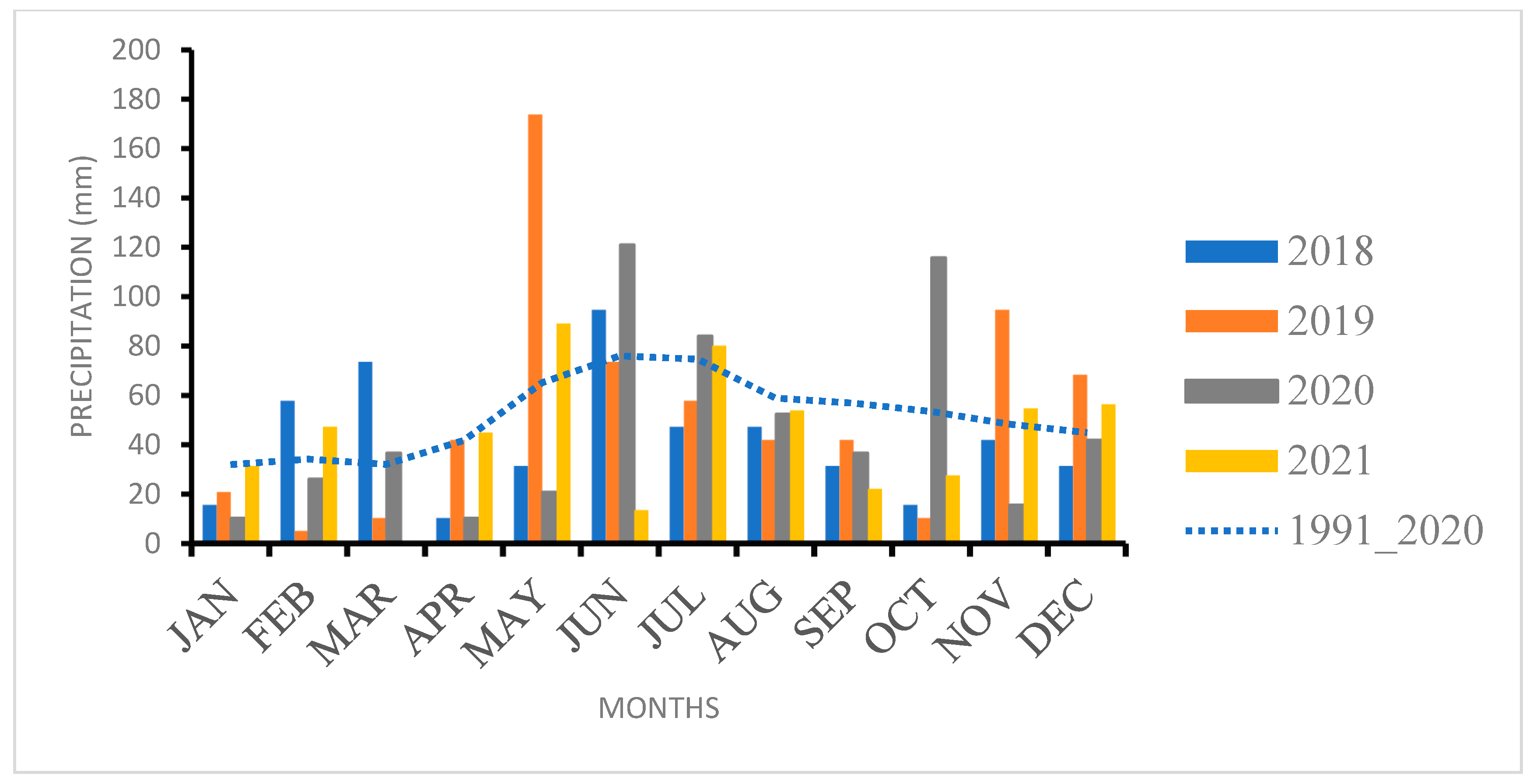

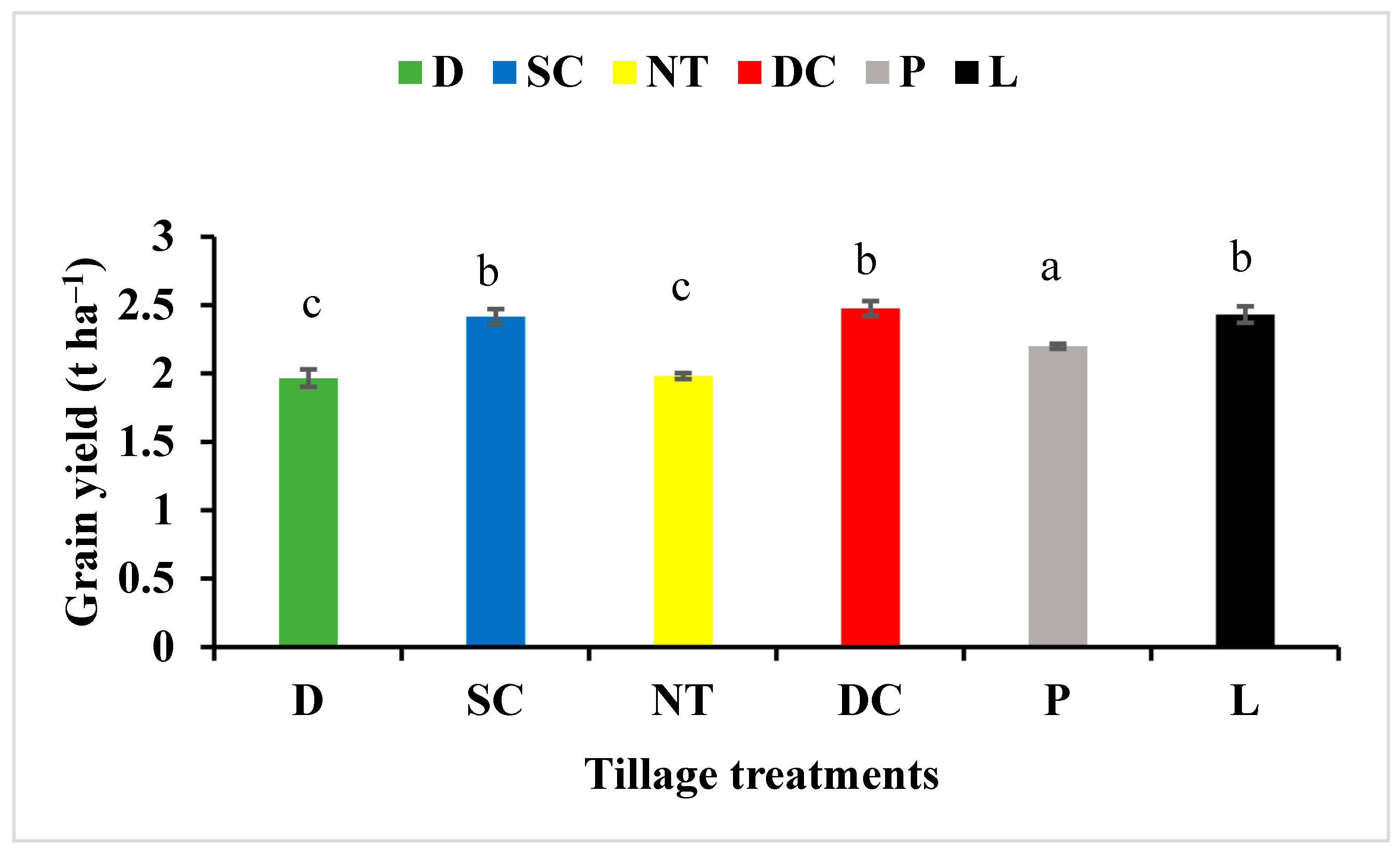


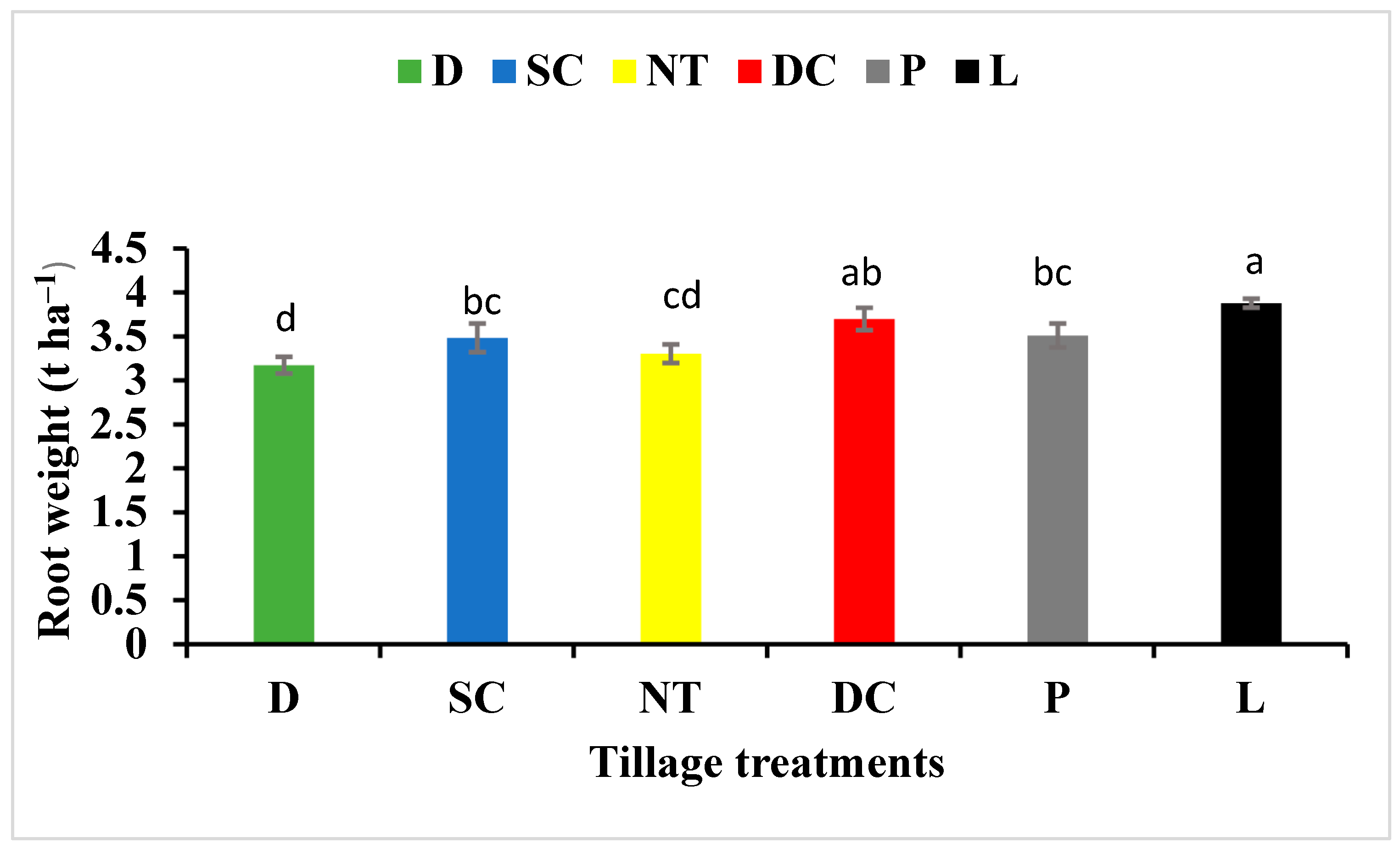
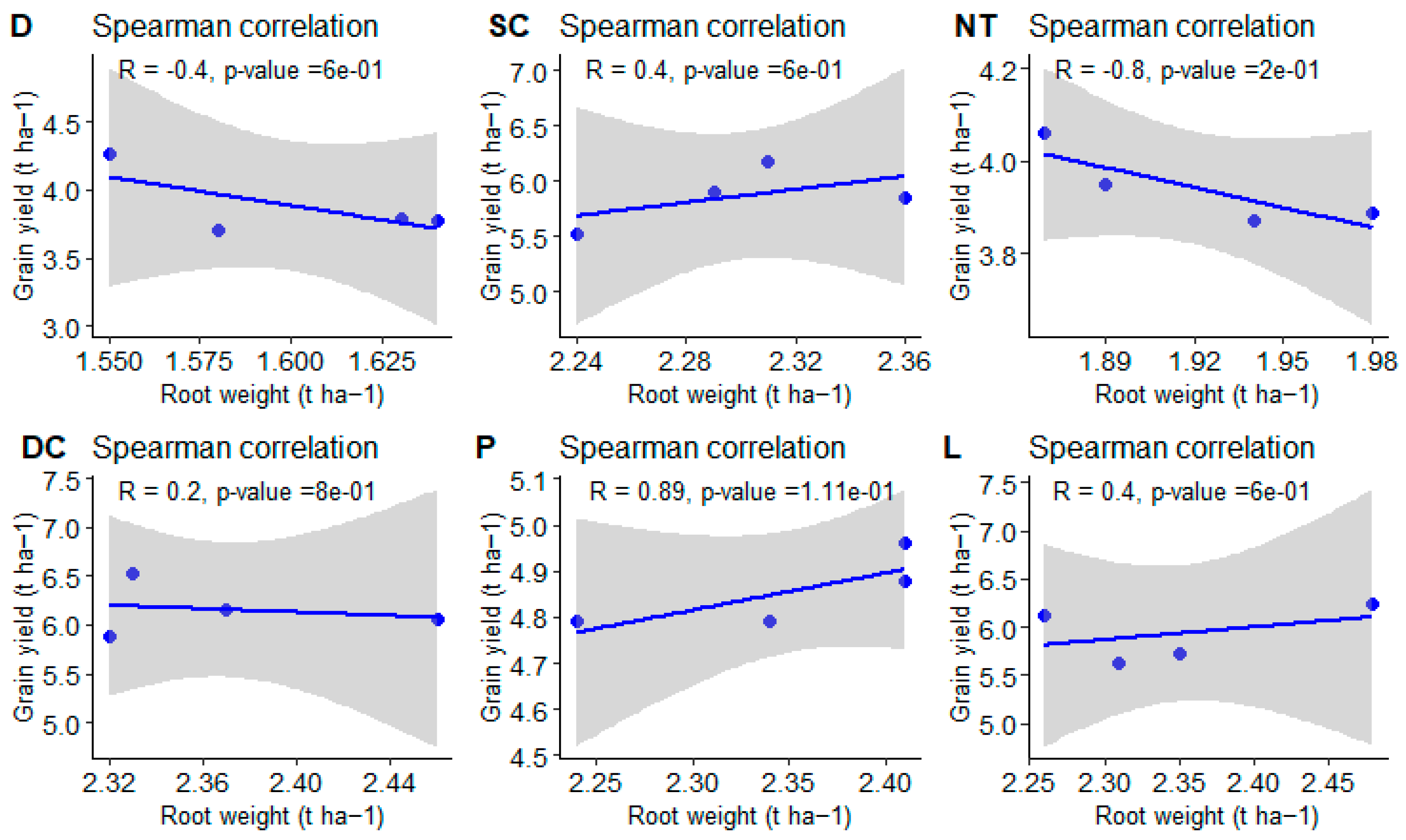
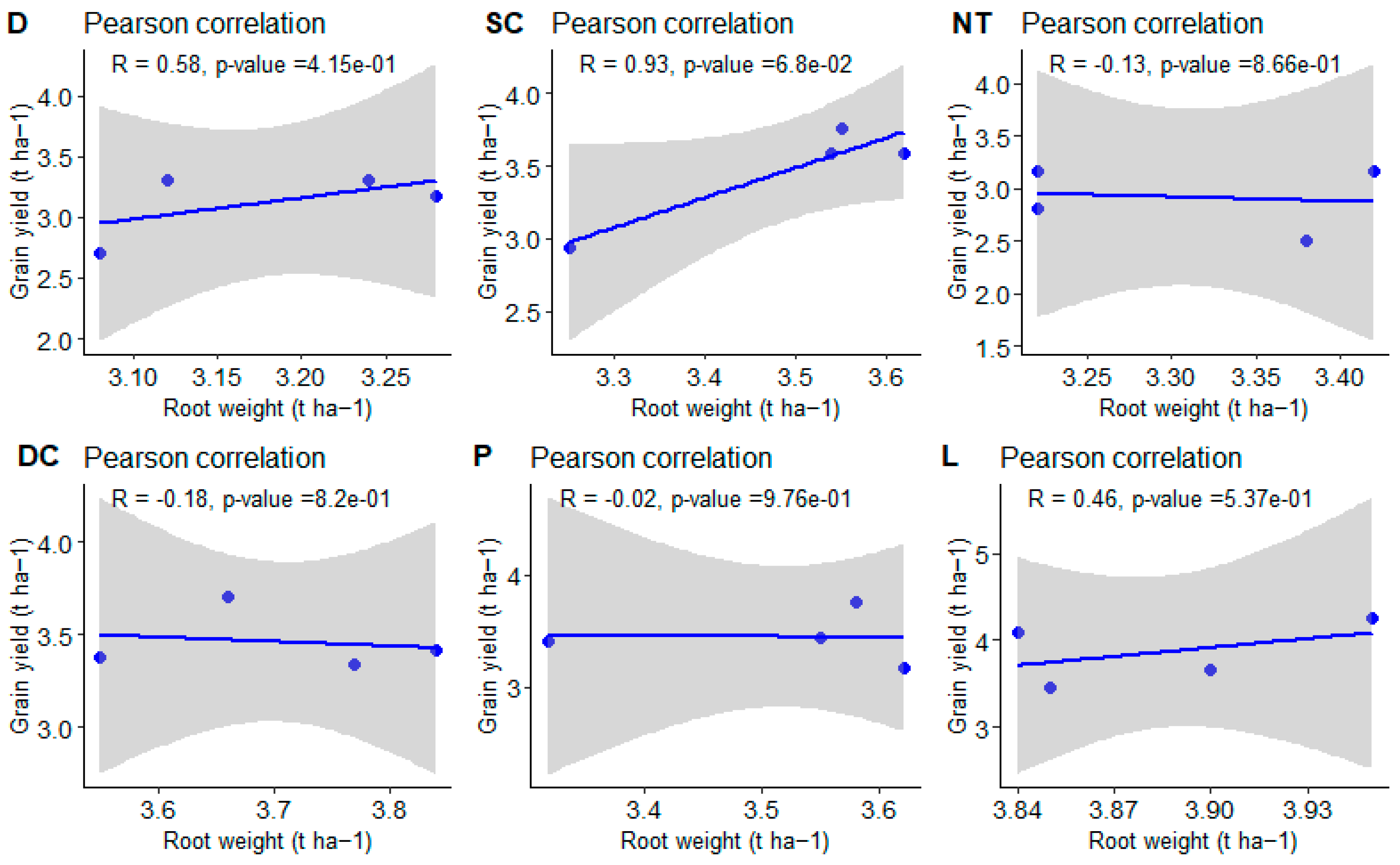
| Activity | Date | Method and Equipment Used |
|---|---|---|
| Wheat | ||
| Basic fertilizer spreading | 17 September 2018 | NPK (20, 100, 60 kg/ha) |
| Foundation cultivation | 10 October 2018 | Ploughing, cultivation with cultivators |
| 11 October 2018 | Loosening, discing, ploughing and processing with a disc | |
| Breaking rolling | 26 October 2018 | |
| Autumn wheat sowing 258 kg/ha | 26 October 2018 | |
| Autumn wheat emergence | 10 November 2018 to 23 December 2018 | Ploughing: weak |
| Head fertilization | 11 February 2019 | 30 kg/ha active ingredient lime-ammonium saltpetre (27% N) |
| Weed killer spraying (Tangazd) | 3 March 2019 | John Deer4830 machine, Mustang Forte 1 L/ha |
| Fungicide spraying | 3 March 2019 | Artea, 0.5 L/ha, in 300 L of water (John Deer 7430 + Vogel Noot Holder, 18 m) |
| Spraying against seed bleaching | 25 July 2019 | |
| Harvesting, chopping straw | 18 July 2018 to 19 July 2019 | John Deer W650/Combine rental, JD W650 |
| Weed control after harvest | 25 July 2019 | Fozat 480 3 L/200 L water |
| Sunflower | ||
| Basic cultivation | 16 September 2020 | Tractor (DC, SC). |
| Fertilization | 31 March 2021 | 120 kg/ha 27% pétisol (GAK) |
| Bed making | 23 April 2021 | Power machine John Deer 7820 and Metalwolf 3.8/4.2 combiner |
| Sowing | 2021 April 23 | Syngenta SY ONESTAR CLP Clearfield plus, 56,000 seeds/ha. Power plant John Deer 7820, seeder KUHN Maxima 6, 12 rows on one plot, sowing depth 5–6 cm |
| Weed control | 31 March 2021 | Fozát 480, 6 L/ha, against Veronica (John Deer 4830, Tangazdaság); |
| Weed control | 1 June 2021 | Pulsar 40SL, 1.2 L/ha + Silvet Star 0.1 L/ha, also Pantera 40 EC 1.2 L/ha (Claas Arion 630 + Horsch Leeb, Tangazdaság, late, medium effect) |
| Plant protection spraying: (against insects) | 25 June 2021 | Monospel 24EW (against insects, 0.2 L/ha) + Pictor (against fungi, 0.5 L/ha, John Deer 4830, Tangazdaság) |
| (A) | ||||||
| Year | 2018/19 | 2020/21 | ||||
| Tillage | 2.2 × 10−16 *** | 2.2 × 10−16 *** | ||||
| Sampling date | 2.2 × 10−16 *** | 2.2 × 10−16 *** | ||||
| Depth | 2.2 × 10−16 *** | 2.2 × 10−16 *** | ||||
| (B) | ||||||
| (1a) | 2018 | |||||
| Depth (cm) | D | SC | NT | DC | P | L |
| 0–10 | 18.21 ± 3.38 aA | 17.75 ± 3.42 aA | 18.99 ± 2.31 aA | 18.25 ± 3.37 aA | 18.83 ± 2.44 aA | 17.69 ± 3.49 aA |
| 10–20 | 26.36 ± 2.64 cB | 25.45 ± 2.49 abB | 26.19 ± 2.64 cB | 25.28 ± 2.34 abB | 25.26 ± 1.95 abB | 24.81 ± 3.14 aB |
| 20–30 | 28.12 ± 2.13 bC | 27.97 ± 2.04 abC | 28.18 ± 1.82 bC | 26.93 ± 2.22 aC | 27.28 ± 2.22 abC | 26.84 ± 2.75 aC |
| 30–40 | 29.06 ± 1.84 abBD | 28.97 ± 2.08 abC | 29.12 ±1.62 abCD | 28.35 ± 2.06 abD | 29.20 ± 1.36 bD | 28.16 ± 2.37 aCD |
| 40–50 | 29.44 ± 1.66 abD | 29.09 ± 2.04 abC | 29.63 ± 1.47 abD | 29.21 ± 1.73 abD | 29.85 ± 1.30 bD | 28.84 ± 2.26 aD |
| 50–60 | 29.35 ± 1.60 abD | 28.58 ± 1.97 aC | 29.58 ± 1.24 bD | 29.32 ± 1.45 abD | 29.88 ± 1.19 bD | 29.02 ± 2.24 abD |
| (1b) | 2018 | |||||
| Sampling date | D | SC | NT | DC | P | L |
| 14 March 2019 | 23.46 ± 4.73 bcA | 22.33 ± 4.75 abA | 24.53 ± 4.52 cA | 22.63 ± 4.52 abcA | 24.75 ± 4.51 cA | 21.27 ± 4.73 aA |
| 11 April 2019 | 25.81 ± 3.67 aB | 26.33 ± 3.36 aB | 25.84 ± 3.49 aAB | 26.74 ± 2.58 aB | 25.84 ± 2.95 aAB | 25.96 ± 3.19 aB |
| 3 June 2019 | 28.23 ± 2.97 bBC | 27.04 ± 4.26 abBC | 27.32 ± 3.91 abBC | 26.46 ± 3.91 abB | 27.19 ± 4.30 abBC | 26.12 ± 3.78 aB |
| 28 June 2019 | 27.52 ± 5.46 aC | 27.29 ± 5.08 aBC | 28.27 ± 4.64 aC | 27.00 ± 5.27 aB | 27.36 ± 4.88 aBC | 27.65 ± 5.07 aBC |
| 15 August 2019 | 28.74 ± 3.59 aC | 28.52 ± 3.16 aC | 28.79 ± 3.14 aC | 28.27 ± 3.42 aB | 28.46 ± 3.46 aC | 28.46 ± 3.49 aC |
| (C) | ||||||
| (2a) | 2021 | |||||
| Depth (cm) | D | SC | NT | DC | P | L |
| 0–10 | 17.48 ± 1.38 abA | 17.33 ± 1.80 abA | 18.10 ± 1.73 cA | 16.59 ± 2.02 bA | 15.52 ± 2.16 aA | 16.99 ± 1.81 bA |
| 10–20 | 25.70 ± 1.57 bB | 25.32 ± 1.86 bB | 25.73 ± 1.63 bB | 24.93 ± 1.72 bB | 23.76 ± 2.03 aB | 24.90 ± 1.61 bB |
| 20–30 | 27.07 ± 1.30 bcC | 27.01 ± 1.43 bcC | 27.15 ± 1.41 cC | 26.89 ± 1.32 abcC | 26.26 ± 1.27 aBC | 26.40 ± 1.38 abC |
| 30–40 | 27.90 ± 1.10 abD | 27.96 ± 1.19 abD | 28.08 ± 1.16 bD | 27.98 ± 1.10 abD | 27.47 ± 1.11 aCD | 27.75 ± 1.10 abD |
| 40–50 | 28.32 ± 0.89 bD | 28.20 ± 0.91 bD | 28.49 ± 0.94 bD | 24.56 ± 0.87 bD | 24.56 ± 9.21 aD | 28.36 ± 0.89 bD |
| 50–60 | 27.95 ± 0.60 aD | 27.85 ± 0.75 aD | 28.09 ± 0.75 aD | 28.21 ± 0.69 aD | 27.87 ± 0.81 aD | 28.20 ± 0.67 aD |
| (2b) | 2021 | |||||
| Sampling date | D | SC | NT | DC | P | L |
| 9 September 2020 | 26.65 ± 4.23 bB | 26.43 ± 4.13 bB | 26.90 ± 4.01 bB | 26.68 ± 4.32 bB | 22.37 ± 9.25 aA | 26.60 ± 4.05 bB |
| 23 October 2020 | 26.54 ± 3.67 aB | 26.36 ± 3.92 aB | 26.36 ± 3.85 aB | 25.61 ± 4.78 aAB | 24.89 ± 4.84 aA | 25.68 ± 4.41 aAB |
| 17 November 2020 | 25.80 ± 3.89 aA | 26.25 ± 3.64 aB | 25.93 ± 3.56 aB | 25.41 ± 4.40 aAB | 24.94 ± 4.69 aA | 25.44 ± 4.09 aAB |
| 16 March 2021 | 24.22 ± 4.27 aA | 23.63 ± 4.56 aA | 23.94 ± 4.26 aA | 23.85 ± 4.69 aA | 23.24 ± 4.47 aA | 23.91 ± 4.59 aA |
| 24 April 2021 | 25.25 ± 3.65 aAB | 25.16 ± 3.69 aAB | 26.37 ± 3.18 aB | 25.76 ± 3.50 aAB | 24.77 ± 3.84 aA | 25.27 ± 3.50 aAB |
Disclaimer/Publisher’s Note: The statements, opinions and data contained in all publications are solely those of the individual author(s) and contributor(s) and not of MDPI and/or the editor(s). MDPI and/or the editor(s) disclaim responsibility for any injury to people or property resulting from any ideas, methods, instructions or products referred to in the content. |
© 2024 by the authors. Licensee MDPI, Basel, Switzerland. This article is an open access article distributed under the terms and conditions of the Creative Commons Attribution (CC BY) license (https://creativecommons.org/licenses/by/4.0/).
Share and Cite
Modiba, M.M.; Ocansey, C.M.; Ibrahim, H.T.M.; Birkás, M.; Dekemati, I.; Simon, B. Assessing the Impact of Tillage Methods on Soil Moisture Content and Crop Yield in Hungary. Agronomy 2024, 14, 1606. https://doi.org/10.3390/agronomy14081606
Modiba MM, Ocansey CM, Ibrahim HTM, Birkás M, Dekemati I, Simon B. Assessing the Impact of Tillage Methods on Soil Moisture Content and Crop Yield in Hungary. Agronomy. 2024; 14(8):1606. https://doi.org/10.3390/agronomy14081606
Chicago/Turabian StyleModiba, Maimela Maxwell, Caleb Melenya Ocansey, Hanaa Tharwat Mohamed Ibrahim, Márta Birkás, Igor Dekemati, and Barbara Simon. 2024. "Assessing the Impact of Tillage Methods on Soil Moisture Content and Crop Yield in Hungary" Agronomy 14, no. 8: 1606. https://doi.org/10.3390/agronomy14081606







